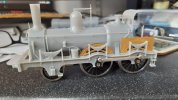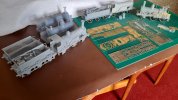You are using an out of date browser. It may not display this or other websites correctly.
You should upgrade or use an alternative browser.
You should upgrade or use an alternative browser.
3D Printing - whether to buy, what to buy and how to use it?
ICH60
Western Thunderer
I uses a Saturn 8K and have had no problems just running with the Chitubox setting and printing at 0 degrees, just change the thickness 50, 30 or 20 micron. The only issue I found is warping issues. over time. Some warping worse than others.And to push home Mick's point about different machines, I have been printing at 50 microns on the Saturn and decided to print one of these files at 20 micron. I expected to get a problem to sort out but the file printed perfectly with no changes to the settings other than the layer thickness. No, I don't understand either.
ianlbsc
Western Thunderer
I use a Saturn 2 with Sirayatec fast in the normal range of colours - currently grey as I can buy 2kg bottles from Amazon at a reasonable price. Usually I print flat to the build plate but ensure there are holes for reducing suction forces. I have been using the Sirayatec given settings put into chitubox and have been very happy. These are just the print with a bit of etched brass not yet fitted.
and these are a few more parts just printed and getting ready to assemble the etched chassis and rods and a few other parts for each.

Some issues with the first tender flares, middle left, cured when I put a hole in the top for the tender dome and water filler, middle top and bottom left.
These are early Stroudley or late Craven locos for the LB&SCR. I am using Slaters wheels and their SG29 motor gearbox which I find I can fit almost anywhere. Just starting to draw the tender for the 2-4-0 and the necessary transfers for which I use two layers - white first layer using a ghost toner and then normal toner colour for the other colours, onto very thin waterslide paper. Works a treat.
I ensure there are holes in the boiler to drain the resin from inside the dome, s/v etc and a through hole for the chimney. Printed all at 0.05 layer height as per the recomendations. I used to print at 0.03 but haven't really noticed any loss of definition. Cheers, Ian

and these are a few more parts just printed and getting ready to assemble the etched chassis and rods and a few other parts for each.

Some issues with the first tender flares, middle left, cured when I put a hole in the top for the tender dome and water filler, middle top and bottom left.
These are early Stroudley or late Craven locos for the LB&SCR. I am using Slaters wheels and their SG29 motor gearbox which I find I can fit almost anywhere. Just starting to draw the tender for the 2-4-0 and the necessary transfers for which I use two layers - white first layer using a ghost toner and then normal toner colour for the other colours, onto very thin waterslide paper. Works a treat.
I ensure there are holes in the boiler to drain the resin from inside the dome, s/v etc and a through hole for the chimney. Printed all at 0.05 layer height as per the recomendations. I used to print at 0.03 but haven't really noticed any loss of definition. Cheers, Ian
Last edited:
simond
Western Thunderer
I needed to print some prototypes for moulded components for work this weekend and took the opportunity to find out the actual costs, compared with Chitubox’ estimates.
Chitubox 126.09ml / 138.7 g / 4.16089 $ / 9h8m30s
part full resin container 654g.
empty resin container 147g
Saturn initial time estimate 09h09m after 1 minute elapsed
Saturn revised time estimate 11h26m after 11 minutes elapsed (19 layers of 2501)
was still going when I went to bed… (no aurora when I checked )
)
Filtered resin back into container 469g
I’ve just set it going again, 07:41 so it’ll finish some time around 7pm this evening. I’ll check that though it’s not really important.
so resin used, 654-469 = 185g.
There’s obviously some wastage when filtering & cleaning the print tank but 46g (24.8%) seems extreme. I didn’t weigh the wet filter paper, but the tank and yellow scraper were wiped down with no more than half a dozen sheets of something soft and beloved by Labrador puppies, again I didn’t weigh them before and after, and I’m not getting them out of the bin.
The density calculation suggests that Chitubox is using a density of 1.1 g/cm3 which is what’s printed on the Siraya FNG data sheet. They do specify this is liquid, I can’t imagine it changes very much as it solidifies, or the parts would come out at odd sizes, which they don’t.
The cost of resin seems to change with the weather, I recently bought 10kgs of FNG, but can’t find the reference. My previous purchase was 4kgs at $167.99 so $42/kg. Chitubox’ estimate is based on $30/kg, so I could update that.
I removed the supports whilst the parts were still green - they weighed 35g.
Part weight was 131g,
Hence total 166g.
I could believe 19g (10%) of wastage on the filter and loo roll, so my guess is that Chitubox does not allow for the supports when calculating resin use, which seems daft.
To check, I’ve gone back to Solidworks, the three parts have volumes of
32088.66 mm3
62350.47
13032.63
total 107471.76mm3 = 107.5cm3 which at 1.1 g/cm3 would weigh in at 118.2g.
That doesn’t tie in with Chitubox estimates, actual resin used or the final part weights!
Other costs - consumables - electricity will be negligible, as is bogroll.
Filter papers are £8.75/25 so £0.35 each, and I find I can use one filter about four times, by simply rinsing it. Say 10p per print.
Replacement FEP film is currently £6.10 for a Saturn. I’ve never needed but have some in stock, should I get a cut. There are recommendations to change the FEP every so often, but I’m in the “it ain’t broke” school of maintenance in this regard. When/if it becomes obviously opaque, I‘ll do it then. I’ve had the machine a couple of years now.
Isopropyl alcohol is £20/5 litres, and I’m guessing I might get 100 prints from a refill, which is about 6 litres in my wash tank. Say 25p per print.
If I assume a straight line allowance for the difference between Chitubox’ estimate and actual resin usage, I can simply multiply the actual resin cost per kg by a factor of 185/138.7 (ie 1.33) and put that in as the resin cost $56 or £47.90 if it’ll do GBP.
And add 35p for consumables. That makes this little job cost about £9.20 per run, and I’ll be doing three sets of bits, so I think I might want paying!
in any case it’s an interesting exercise to work out the likely cost of making something this way.
Chitubox 126.09ml / 138.7 g / 4.16089 $ / 9h8m30s
part full resin container 654g.
empty resin container 147g
Saturn initial time estimate 09h09m after 1 minute elapsed
Saturn revised time estimate 11h26m after 11 minutes elapsed (19 layers of 2501)
was still going when I went to bed… (no aurora when I checked
 )
)Filtered resin back into container 469g
I’ve just set it going again, 07:41 so it’ll finish some time around 7pm this evening. I’ll check that though it’s not really important.
so resin used, 654-469 = 185g.
There’s obviously some wastage when filtering & cleaning the print tank but 46g (24.8%) seems extreme. I didn’t weigh the wet filter paper, but the tank and yellow scraper were wiped down with no more than half a dozen sheets of something soft and beloved by Labrador puppies, again I didn’t weigh them before and after, and I’m not getting them out of the bin.
The density calculation suggests that Chitubox is using a density of 1.1 g/cm3 which is what’s printed on the Siraya FNG data sheet. They do specify this is liquid, I can’t imagine it changes very much as it solidifies, or the parts would come out at odd sizes, which they don’t.
The cost of resin seems to change with the weather, I recently bought 10kgs of FNG, but can’t find the reference. My previous purchase was 4kgs at $167.99 so $42/kg. Chitubox’ estimate is based on $30/kg, so I could update that.
I removed the supports whilst the parts were still green - they weighed 35g.
Part weight was 131g,
Hence total 166g.
I could believe 19g (10%) of wastage on the filter and loo roll, so my guess is that Chitubox does not allow for the supports when calculating resin use, which seems daft.
To check, I’ve gone back to Solidworks, the three parts have volumes of
32088.66 mm3
62350.47
13032.63
total 107471.76mm3 = 107.5cm3 which at 1.1 g/cm3 would weigh in at 118.2g.
That doesn’t tie in with Chitubox estimates, actual resin used or the final part weights!
Other costs - consumables - electricity will be negligible, as is bogroll.
Filter papers are £8.75/25 so £0.35 each, and I find I can use one filter about four times, by simply rinsing it. Say 10p per print.
Replacement FEP film is currently £6.10 for a Saturn. I’ve never needed but have some in stock, should I get a cut. There are recommendations to change the FEP every so often, but I’m in the “it ain’t broke” school of maintenance in this regard. When/if it becomes obviously opaque, I‘ll do it then. I’ve had the machine a couple of years now.
Isopropyl alcohol is £20/5 litres, and I’m guessing I might get 100 prints from a refill, which is about 6 litres in my wash tank. Say 25p per print.
If I assume a straight line allowance for the difference between Chitubox’ estimate and actual resin usage, I can simply multiply the actual resin cost per kg by a factor of 185/138.7 (ie 1.33) and put that in as the resin cost $56 or £47.90 if it’ll do GBP.
And add 35p for consumables. That makes this little job cost about £9.20 per run, and I’ll be doing three sets of bits, so I think I might want paying!
in any case it’s an interesting exercise to work out the likely cost of making something this way.
Last edited:
timbowales
Western Thunderer
for?????)
Don’t leave us in suspense.
Tim T
Don’t leave us in suspense.
Tim T
simond
Western Thunderer
Patience, dear fellow, patience…for?????)
Don’t leave us in suspense.
Tim T
